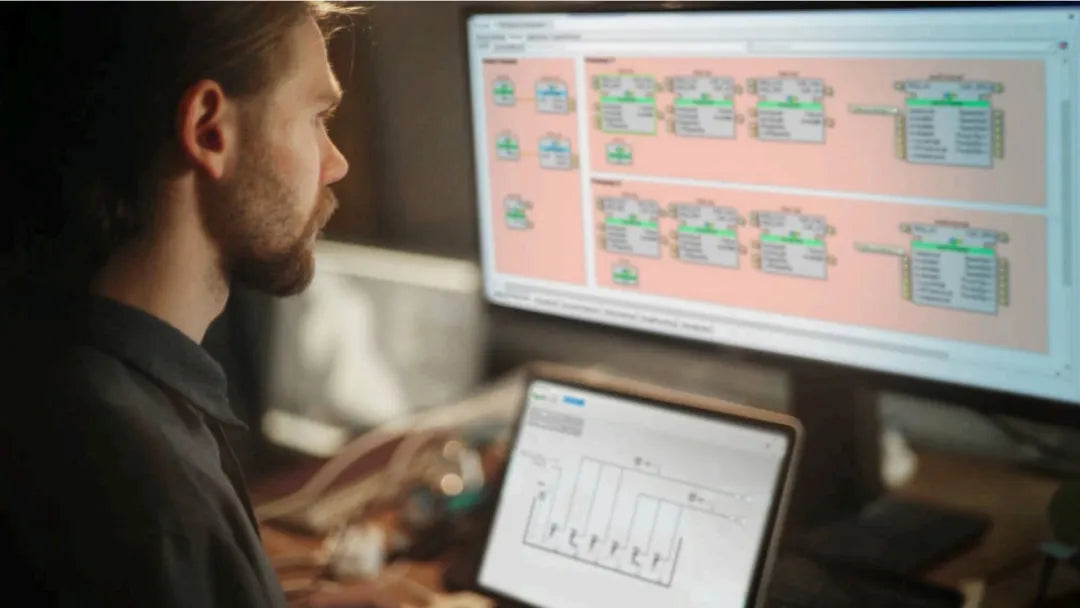مستقبل التصنيع الذكي: احتضان الأتمتة العالمية والمعايير المفتوحة

احتضان الأتمتة العالمية: عصر جديد للمصانع الذكية
مقدمة في الأتمتة المفتوحة
تمثل الأتمتة المفتوحة قفزة تحويلية للمصانع الذكية، حيث تمزج بين المرونة وقابلية التشغيل البيني. يعالج هذا النهج القيود المفروضة على أنظمة الملكية، مما يعزز بيئة تصنيع أكثر قدرة على التكيف وكفاءة. من خلال الاستفادة من معيار IEC 61499، تعمل الأتمتة المفتوحة على فصل الأجهزة عن البرامج، مما يعزز إمكانية الابتكار ويقلل من تقييد البائعين.
ضرورة التوحيد القياسي
وقد لا يستوعب المصنعون والمهندسون بشكل كامل التحولات الوشيكة في عمليات المصنع. وتؤكد الدعوة إلى معايير الأتمتة، وخاصة في قطاع أنظمة التحكم الموزعة (DCS)، على الطلب الأوسع على النمطية والمرونة. ومن الممكن أن يؤدي توحيد عمليات التشغيل الآلي إلى إزالة قيود الملكية التي تخنق الابتكار وتبطئ التقدم التكنولوجي.
وعد IEC 61499
تقدم المواصفة IEC 61499، وهي تطور لمعيار IEC 61131، طريقة أكثر نمطية وقابلة لإعادة الاستخدام لتصميم نظام التحكم. فهو يبسط تعبئة مكونات البرامج ويدعم إعادة التكوين الديناميكي، مما يوفر أساسًا لتطبيقات Industry 4.0 وإنترنت الأشياء الصناعي (IIoT). يعد هذا المعيار بكسر الحواجز، مما يتيح لبرامج التحكم المتنوعة العمل عبر منصات الأجهزة المختلفة.
تشكيل الأتمتة العالمية
إن ظهور Universal Automation ومنظمات مثل UniversalAutomation.org يسلط الضوء على تحول كبير في ممارسات الصناعة. تعمل هذه الجمعية غير الربحية على تعزيز اعتماد الحلول المستندة إلى IEC 61499، والتي تهدف إلى إنشاء نظام بيئي للتوصيل والتشغيل. تعتبر هذه التطورات حاسمة لتمكين المستخدمين النهائيين من اختيار المنتجات الأكثر ملائمة لتطبيقاتهم المحددة، دون التقيد بمورد واحد.
تحسين Ethernet-APL لتواصل الميدان
تمثل Ethernet-APL (الطبقة المادية المتقدمة) تقدمًا حاسمًا في تكنولوجيا الاتصالات الميدانية. من خلال دعم تشغيل الكابلات الأطول، والسلامة الجوهرية، والأجهزة التي تعمل بتقنية Ethernet، تعمل Ethernet-APL على تحسين الاتصال والاستقرار في أتمتة العمليات. تم إعداد هذا المعيار لتبسيط توسيع اتصالات Ethernet لتشمل الأجهزة الميدانية، مما يوفر حلاً أكثر موثوقية وقابلية للتطوير.
الأجهزة الذكية وتدفق البيانات
يعمل تكامل الأجهزة الذكية على توسيع تدفق البيانات داخل البيئات الصناعية. بدءًا من أجهزة إدارة الأحمال الذكية وحتى أجهزة الاستشعار المتقدمة، تعمل القدرة على جمع البيانات وتحليلها دون استخدام أسلاك التحكم التقليدية على تحسين الصيانة التنبؤية وتحسين العمليات. يشير انتشار الأجهزة الذكية عبر الأدوات المختلفة إلى التحول نحو أنظمة تصنيع أكثر ذكاءً واستجابة.
دور التحكم في الحافة
أصبح التحكم في الحافة حجر الزاوية في عمليات المصنع المستقبلية. من خلال الجمع بين البرامج والأجهزة في بيئة غير مملوكة، يسمح التحكم الطرفي بخوارزميات تحكم قابلة للبرمجة ومحمولة. نظرًا لأن جميع الأجهزة مترابطة عبر شبكة إيثرنت، تصبح القدرة على نشر وإدارة برامج التحكم عبر منصات الأجهزة المختلفة أمرًا ممكنًا، وذلك بفضل معايير الأتمتة المفتوحة.
نتطلع إلى المستقبل
يعتمد الجيل التالي من منصات التشغيل الآلي على مبادئ التشغيل الآلي المفتوح والمعيار IEC 61499. وتعد هذه المنصات ببنية موزعة، مما يتيح نشر خوارزميات التحكم عبر مختلف وحدات التحكم وأجهزة الإدخال/الإخراج. يسلط هذا التحول من الأنظمة التي تركز على الأجهزة إلى الأنظمة التي تركز على البرمجيات الضوء على الحاجة إلى أدوات تطوير مبتكرة لتلبية المتطلبات المتطورة.
للحصول على مجموعة واسعة من منتجات وحلول الأتمتة التي تتماشى مع هذه التطورات، قم بزيارة PLC DCS Pro. تقدم منصتنا منتجات متطورة لمساعدتك في البقاء في المقدمة في المشهد المتطور للأتمتة الصناعية.
خاتمة
تمثل الأتمتة المفتوحة خطوة هامة نحو أنظمة مصانع أكثر مرونة وقابلة للتشغيل البيني. مع تحول الصناعة إلى الحلول القائمة على البرمجيات وتبني معايير جديدة مثل IEC 61499، تزداد إمكانية الابتكار والكفاءة. سيؤدي تبني هذه التغييرات إلى تمكين الشركات المصنعة من تلبية متطلبات الأتمتة الحديثة بشكل أفضل، مما يؤدي إلى بيئات إنتاج أكثر مرونة واستجابة.

























